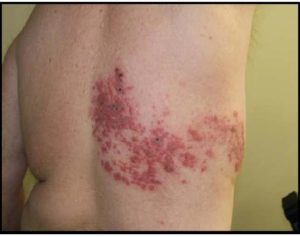 We have been administering the new Shingrix vaccine for prevention of herpes zoster, also called shingles. As you likely know, the disease is a typically painful rash along a single nerve that represents a breakout of dormant virus from a long-ago chicken pox infection. The old vaccine, which we administered to most of you over 50 years of age, was moderately effective. The new vaccine is dramatically more effective, typically over 90% at all age groups.
We have been administering the new Shingrix vaccine for prevention of herpes zoster, also called shingles. As you likely know, the disease is a typically painful rash along a single nerve that represents a breakout of dormant virus from a long-ago chicken pox infection. The old vaccine, which we administered to most of you over 50 years of age, was moderately effective. The new vaccine is dramatically more effective, typically over 90% at all age groups.
Side Effect Update
There are local and systemic side effects that occur with Shingrix that are a bit more intense than we had earlier heard, and so warrant presenting. In particular, in about 10% of recipients, the severity of the local sore arm reaction (pain, redness and swelling) can be quite significant, and require icing and Advil or equivalent and may least several days. A bit over 3/4 of recipient had at least some sore arm.
In addition, systemic reactions, including generalized aches, fatigue, headache, fever, chills and GI issues lasting more than a day that require rest at home, are significant. About 1 person in 6 had such symptoms, which last 1-2 days and occasionally 3 days.
A second injection is required, from 2 to 6 months after the first. The same adverse effects are likely to occur. The CDC strongly emphasizes that the benefit is worth the possible uncomfortable side effects. Dr. Sobel and I agree with that assessment. It is unfortunate, however, that any adverse effect need be expected with any immunization. We likely will recommend premedication with moderate dose Advil (such as 600 mg before the shot, and likely 400 mg three times daily for several days afterward).
Coverage and Cost
Major commercial health insurers (BC, Tufts, Harvard Pilgrim and others) appear to be covering Shingrix for everyone they insure between age 50 and 65 without copay, but we do not know that 100% sure. Still worthwhile to ask your insurer.
For Medicare, there is still uncertainty. Payment for Shingrix is through Medicare Part D. You can get the shot at pharmacies that have stocked Shingrix, but there likely will be a copay of some substantial size (on the total charge of about $175) that depends on your exact Part D plan. So you need to check with your Part D provider yourself.
Similarly, we believe, but do not yet know, that Part D will cover the immunization in our Orchard Health Care office. We have the vaccine and are pleased to provide it. It is expensive, and our cost is close to the $175 fee. Doctors’ offices cannot bill Medicare Part D directly. We believe you will need to pay our office the $175 vaccine charge and then send a receipt to your Part D provider to get reimbursement, which likely will be partial. We suspect that your net cost will be the same if you get the shot (and pay copay) at a pharmacy, or get it with us and pay us the charge and then receive reimbursement net of a copay. More to be revealed on that as soon as we find out.
You should still check with your Medicare Part D provider and ask them exactly what they will cover for administration of Shingrix at your doctor’s office or the pharmacy.
The Medicare situation is clearly more complex and confusing than it should be. This is the US of A where drug costs frequently make no sense.

